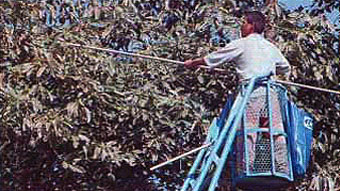Harvesting of the fruit before reaching an optimal point can lead to deficient ripening and quality. On the other hand, when the harvest of the fruit is carried out after the optimal point, its post-harvest life could be diminished. In order to determine this optimal harvest point, two quantitative maturation and harvest indexes are used: oil and dry matter contents. However, other complementary indexes can be considered, such as the size of the fruit and the appearance of the seed skin.
Dry matter is measured by placing approximately 10 g of thin slices of avocado pulp into Petri dishes. The uncovered dishes are placed in a microwave oven and cooked until constant weight (from 5 to 15 min). Dry matter content should be 22.8% for "Hass" and 21% for "Fuerte". It is also important to consider that a large size of the fruit it is not always an indicator of advanced maturation. When the skin of the seed appears thin and changes its color to dark brown, the fruit tissue is probably ripe (Yahia, 2001).
Maturation indexes should be considered at the beginning of the export season. The dry matter analysis can also be performed using a domestic or microwave oven, and does not require an extensive or sophisticated training. Based on the experiences obtained in Mexico for export fruit, it can be established that avocados should have an average of 22% of dry matter, and the lowest value of a sample should not be under 20% (Sánchez-Pérez, 2001). The harvest of the fruit destined to the Mexican domestic market is usually done by hand or with the help of hooks, which grab the fruit from the peduncle and let it fall into the ground. The fruit stays on the ground for several hours and in some cases overnight, before they are collected into boxes or sacks. The first damage to the fruit is made by the pull-off, fall, and exposure to the elements (Morales et al., 2000).
The harvest of higher-priced fruit is made with the help of a ladder and "ganchos" (hooks), which are metallic or wooden sticks of approx. 3 m long, with a collector bag and a sharp metallic hook attached at the end. The hook cuts the peduncle and the fruit falls into the bag. In Israel, a collector machine is used. This machine has a mobile tower of approx. 5 m in height, which cuts the fruit and collects it into a bag, as directed by an operator. In Mexico, harvesting machines consist of a platform that is elevated by an operator (Figure 1 Harvesting machine to collect avocado). A worker stands on the platform, cuts, and collects the fruit.

Figure 1: Harvesting machine to collect avocado
The manual harvest should be done bearing in mind the following points:
- Harvest should be done when fruits have reached 21% of dry matter in the pulp.
- Use of "ganchos" and ladders in good conditions (Figure 2 Hooks or "ganchos" to collect avocado)

Figure 2: Hooks or "ganchos" to collect avocado
source: SAGAR 1999.
- Avoid mechanical damage that could lower the commercial value, since it affects pulp firmness, turning it brown and soft. Mechanical damage and peel injuries accelerate water loss, respiration and ethylene release, and constitute entry pathways for pathogen attacks.
- The peduncle should be cut and not separated from the tree by pulling down the fruit. Avocados should never fall into the ground or be excessively exposed to the sun. The exposure of avocados to the sun increases the internal temperature of the fruit, which triggers physiological and chemical maturation processes that speed up maturation and decay.
- The cut of the peduncle should leave a portion of 8 to 10 mm on the branch, in order to avoid a fast maturation of the fruit. When the peduncle is completely separated, the internal respiration of the fruit increases, helping to the entry of pathogens
- The harvested fruit should be collected in proper places, such as boxes or baskets, in order to avoid mechanical damage.
Source : http://www.fao.org/inpho/content/compend/text/ch30/ch30_02.htm
|

